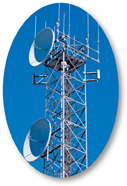34.1 The Endocrine System
 What are the components of the endocrine system?
What are the components of the endocrine system? How do hormones affect cells?
How do hormones affect cells?
hormone
target cell
exocrine gland
endocrine gland
prostaglandin
Compare/Contrast Table As you read, make a table that compares and contrasts the two different types of hormones.
THINK ABOUT IT If you had to get a message to just one or two friends, what would you do? One solution would be to make a telephone call that would carry your message directly to those friends over telephone wires. But what if you wanted to send a message to thousands of people? You could broadcast your message on the radio so that everyone tuned to a particular station could hear it. Just like you, cells send messages, too. They can make a direct call or send out a broadcast.

Hormones and Glands
 What are the components of the endocrine system?
What are the components of the endocrine system?
Your nervous system works much like a telephone. Many impulses move swiftly over a system of wirelike neurons that carry messages directly from one cell to another. But another system, the endocrine system, is more like a radio, “broadcasting” chemical messages. These chemical messengers, called hormones, are released in one part of the body, travel through the blood, and affect cells in other parts of the body.  The endocrine system is made up of glands that release hormones into the blood. Hormones deliver messages throughout the body. In the same way that a radio broadcast can reach thousands or even millions of people in a large city, hormones can affect almost every cell in the body.
The endocrine system is made up of glands that release hormones into the blood. Hormones deliver messages throughout the body. In the same way that a radio broadcast can reach thousands or even millions of people in a large city, hormones can affect almost every cell in the body.
Hormones Hormones act by binding to specific chemical receptors on cell membranes or within cells. Cells that have receptors for a particular hormone are called target cells. If a cell does not have receptors for a particular hormone, the hormone has no effect on it.
In general, the body's responses to hormones are slower and longer lasting than its responses to nerve impulses. It may take several minutes, several hours, or even several days for a hormone to have its full effect on its target cells. A nerve impulse, on the other hand, may take only a fraction of a second to reach and affect its target cells.
Many endocrine functions depend on the effects of two opposing hormones. For example, the hormone insulin prompts the liver to convert blood glucose to glycogen and store it. The hormone glucagon prompts the liver to convert glycogen to glucose and release it in the blood. The opposing effects of insulin and glucagon maintain homeostasis by keeping blood glucose levels within a narrow range.

Table of Contents
- Formulas and Equations
- Applying Formulas and Equations
- Mean, Median, and Mode
- Estimation
- Using Measurements in Calculations
- Effects of Measurement Errors
- Accuracy
- Precision
- Comparing Accuracy and Precision
- Significant Figures
- Calculating With Significant Figures
- Scientific Notation
- Calculating With Scientific Notation
- Dimensional Analysis
- Applying Dimensional Analysis




